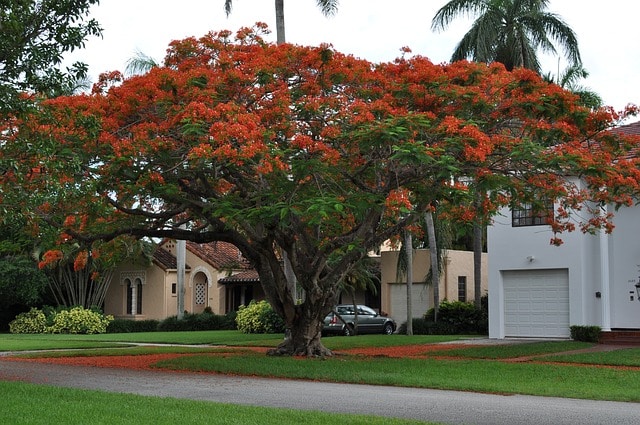It bears large scarlet flowers that look very attractive against a green leafy background.
A less common variety bears smaller, orange flowers.
In the presence of sunlight and good, well-drained soil, the tree grows to an average height of about 16 meters.
In poor, water-logged soil, Delonix regia growth becomes stunted.
In countries with marked wet and dry seasons, the flamboyant tree sheds its leaves at the end of the wet season and remains bare during the dry (winter) season.
New leafy shoots and flowers appear with the onset of the wet (spring) season.
In this part of the world, since the seasons are not marked, each tree has its own life circle, shedding its leaves and flowering periodically at intervals of 7 to 10 months.
The Trunk
The main trunk of the Delonix regia tree is short and divides into several large branches that spread out to give the tree a large umbrella-shaped crown.
Branching is more pronounced at the peripheral branches of the tree and the leaves are borne near the surface of the crown.
Thus, the tree receives plenty of sunlight.
The bark of the flamboyant tree is smooth and silvery-grey in color.
The Roots
The flamboyant tree has strong, well-developed roots so that the tree seldom gets blown down.
Buttress roots are often present and these give additional support to the tree.
The Leaves
The flamboyant tree has compound, bipinnate leaves: each leaf is divided into leaflets, or pinnae, which are further divided into pinnules.
There are no terminal pinnae or pinnules. Each pinnule is a delicate structure about 10mm long and 4mm wide.
It is oblong and sessile with a slightly oblique base and a rounded tip.
Stipules are present. the leaflets fold at dusk.
The Inflorescence
The flowers of Delonix regia occur in an inflorescence, the older ones situated towards the base, and the younger ones towards the tip of the flower stalk.
Each flower is complete, irregular, and bisexual.
The flower has five sepals which are green on the outer side and scarlet on the inner side.
There are four scarlet petals with long stalks and one large and attractive standard petal which acts as a honeyguide.
The standard petal is whitish or pinkish with scarlet streaks, an attractive broad scarlet border, a yellowish center, and a scarlet stalk.
The flower has five long outer stamens that are red in color.
In the center of the flower lies a single stigma that ends in a green monocarpellary ovary.
The flowers stay in bloom for two days only. In the orange-flowered variety, the standard petal is less showy because it does not have a striking border.
The Fruit
The flowers of Delonix regia are usually pollinated by butterflies.
The ovary of each flower grows into a legume or pod.
The mature pod is about 30 to 60cm long, slightly curved, and woody.
It splits open to release blackish seeds.
Propagation
Under suitable conditions, the seedlings grow very rapidly and reach a height of about eight meters in four years. the tree can be propagated by marcotting.







